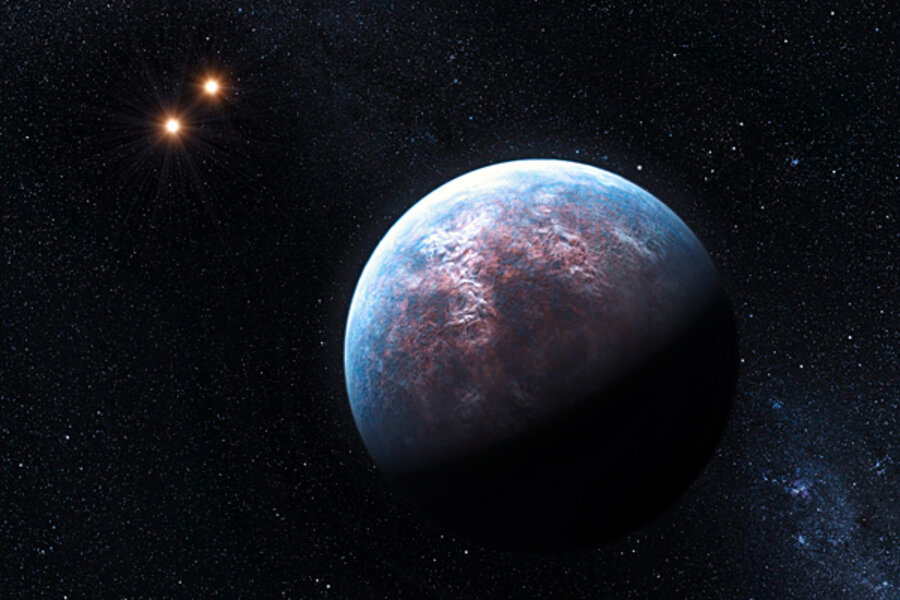Amazing planets: mini solar system, 'Star Wars' lookalike among new finds
Loading...
Planets orbiting other stars may be a dime a dozen in the Milky Way, but cheap hardly means boring.
From a new pair of planets like Tatooine of "Star Wars" fame, each with its own pair of suns, to a trio of small rocky planets zipping around a red-dwarf star, the cosmos presents a breathtaking plethora of planetary systems. A new estimate suggests that the Milky Way's population of planets exceeds 100 billion.
These are among the planet-hunting highlights from this week's winter meeting of the American Astronomical Society in Austin, Texas.
The ultimate goal is to find Earth-size planets orbiting in a star's habitable zone – the place where a planet, with the right atmosphere, can host water as liquid, ice, and gas on its surface.
While no Earth-scale planets in this Goldilocks zone have yet appeared, "these latest observations make it extremely likely that Earth-scale planets in the habitable zone exist, probably in large numbers," says Philip Armitage, an astrophysicist at the University of Colorado at Boulder.
Three results highlighted at the meeting speak volumes about how far researchers have come in the 16 years since astronomers detected the first exoplanet orbiting a sun-like star.
Between 600 and 700 extrasolar planets have been confirmed, depending on which online catalog keeps tally. NASA's Kepler mission has accounted for 35 of these, with another 2,326 "planet candidates" awaiting evaluation.
Yet this number pales beside an estimate offered by a research team that presented its results at the meeting and in the Jan. 12 issue of the journal Nature.
Based on a six-year survey of stars using a technique known as gravitational lensing, in which an intervening star's gravity magnifies the light from a star far behind it, the team estimates that 17 percent of all stars in the galaxy host a planet of Jupiter's mass or greater. About 52 percent of stars host Neptune-class planets, while 62 percent host so-called super Earths.
Given the trend toward higher numbers of lower-mass planets, "statistically, every star in the galaxy should have at least one planet, and probably more," according to Kailash Sahu, a researcher a the Hubble Space Telescope Institute in Baltimore and a member of the research team.
What might some of those planetary systems look like? How about Tatooine? Data from NASA's Kepler mission have revealed two new systems in which a planet is orbiting a binary star.
Kepler scientists unveiled the first such system in September. But it was unclear then how many such systems might lurk in the Milky Way.
With two more in the can, "we know that it is possible, if not probable, that there are at least millions in the galaxy," William Welsh, a researcher at San Diego State University and a member of the Kepler team, said in a statement. The results also appear in the Jan. 12 issue of Nature.
Both planets are about Saturn's size. One of the two, Kepler 34-b, orbits its pair of stars once every 289 days. Meanwhile, the stars eclipse one another every 28 days. Kepler 35-b's stars are a bit smaller, eclipsing each other every 21 days. The planet orbits its twin suns every 131 days.
Such systems would keep organisms on their evolutionary toes. Seasons would repeat several times a year. And the planets would be subject to swings from hot to cold – a function of ever-changing distances as their gravitational fields interact.
The potential effects of these changes on an organism's evolution "is a fascinating topic that we are just beginning to explore," Dr. Welsh notes.
Sounds too daunting for a vacation spot? Try planets around a red dwarf.
Another team reported discovering the smallest planets yet confirmed. One is roughly the size of Mars. The other two are smaller than Venus. All three orbit a dim red-dwarf star some 130 light-years from Earth. The star is only about 70 percent larger than Jupiter.
The planets are orbiting too close to the star to fall within its habitable zone. But the find is intriguing, nonetheless.
Red dwarfs represent some 80 percent of all the stars in the galaxy, says John Johnson, an astronomer at the California Institute of Technology and a member of the team reporting the discovery. If the discovered planets are any indication, he notes, red dwarf stars throughout the galaxy could be "swarming with little habitable planets."
The team's results have been accepted for publication in the Astrophysical Journal.





